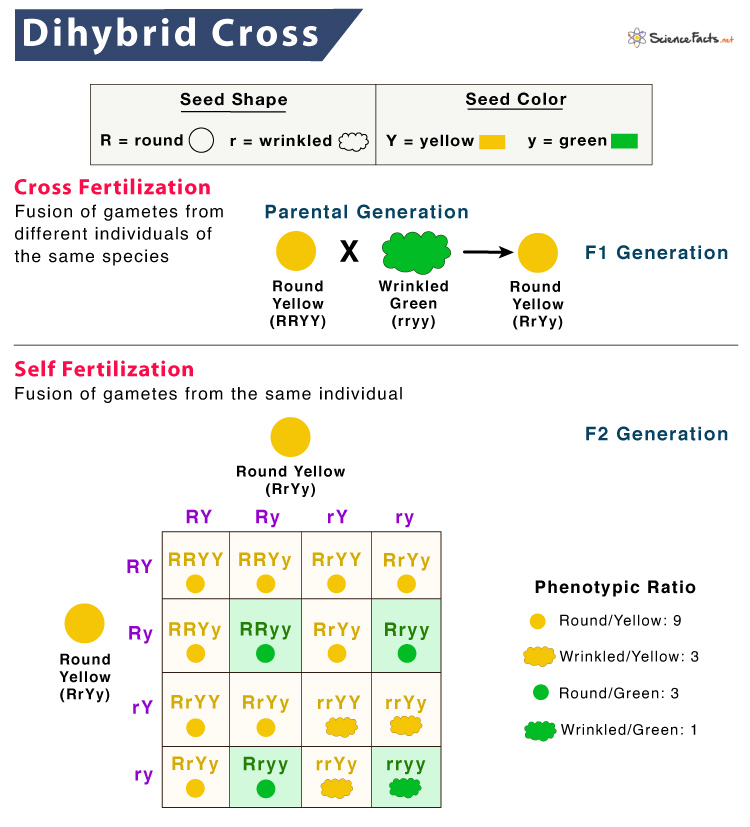Among all, the law of independent assortment was discovered while performing dihybrid crosses between the pea plants.
What is a Dihybrid Cross
How to Set Up Dihybrid Cross
Examples of Dihybrid Cross
What is a Dihybrid Test Cross
Monohybrid Cross vs. Dihybrid Cross
Here, the individuals are homozygous for a particular trait. One parent contains homozygous dominant alleles, while the other contains homozygous recessive alleles. The offspring, or F1 generation, formed after crossing the two parents is heterozygous for the specific traits being studied. Thus, all of the F1 individuals possess a hybrid genotype, expressing dominant phenotypes for each trait.
F1 Generation
A true-breeding pea plant with round seed shape and yellow seed color (RRYY) is cross-pollinated with another true-breeding plant with wrinkled seed shape and green seed color (rryy). The resulting F1 generation is all found to be heterozygous for round seed shape and yellow seed color (RrYy). All F1 offspring were found to be phenotypically identical, producing yellow seed color and round seed shape.
F2 Generation
Mendel continued with his experiment with the self-pollination of F1 progeny plants. To his surprise, the plants exhibited a 9:3:3:1 phenotypic ratio of seed shape and seed color. Nine out of the sixteen plants were found to exhibit round, yellow seeds. Three of them exhibited round green seeds. Another three gave wrinkled, yellow seeds, and the remaining one plant gave wrinkled green seeds. Thus, F2 generation exhibited four different phenotypes and nine different genotypes.
Genotypic and Phenotypic Ratios
Genotypes determine the phenotype in an organism. Thus, a plant exhibits a specific phenotype based on whether its alleles are dominant or recessive. One dominant allele leads to a dominant phenotype being expressed. The other way for a recessive phenotype to appear is for a genotype to possess two recessive alleles. Both homozygous and heterozygous dominant genotypes are expressed as dominant. In the experiment performed by Mendel, yellow (Y) and round (R) are dominant alleles, and green (y) and wrinkled (r) are recessive. The possible phenotypes and their genotypes are given below:
How to Make a Dihybrid Cross Punnett Square
The above result is represented using a 4 x 4 Punnett square. All the four possible combinations of gametes for yellow seed color and round seed shape pea plant are placed from top to bottom of the first column. For green seed color and wrinkled seed shape, pea plant in the top row from left to right. The Punnett square is given below:
Purpose of Mendel’s Experiment
His experiment with dihybrid crosses shows all the possible offspring that can come from two given parents. Crosses involving multiple traits also help us understand the type of inheritance pattern that governs each trait. It also works to determine a specific phenotypic ratio and how many offspring have a specific trait. Dihybrid crosses gave rise to independent assortment law, which states that pairs of alleles are inherited independently if their loci are on separate chromosomes. In other words, the genes are unlinked. In a test cross, an individual with an unknown genotype is crossed with a homozygous recessive individual. The unknown genotype can be obtained by analyzing the phenotypes in the offspring. The result of a dihybrid test cross-ratio is represented using a Punnett square. If the unknown genotype is heterozygous, a test cross with a homozygous recessive individual will result in a 1:1:1:1 ratio of the offspring’s phenotypes. Example Here, one of the heterozygous parents for seed color and seed shape (RrYy) is crossed with a homozygous plant for both the traits (rryy). The test cross produces four possible genetic combinations RrYy, Rryy, rrYy, and rryy in a ratio of 1:1:1:1. Thus, a pea plant’s genotype producing dominant round and yellow seeds can be determined when test crossed with a wrinkled green plant having recessive alleles for both the traits.
